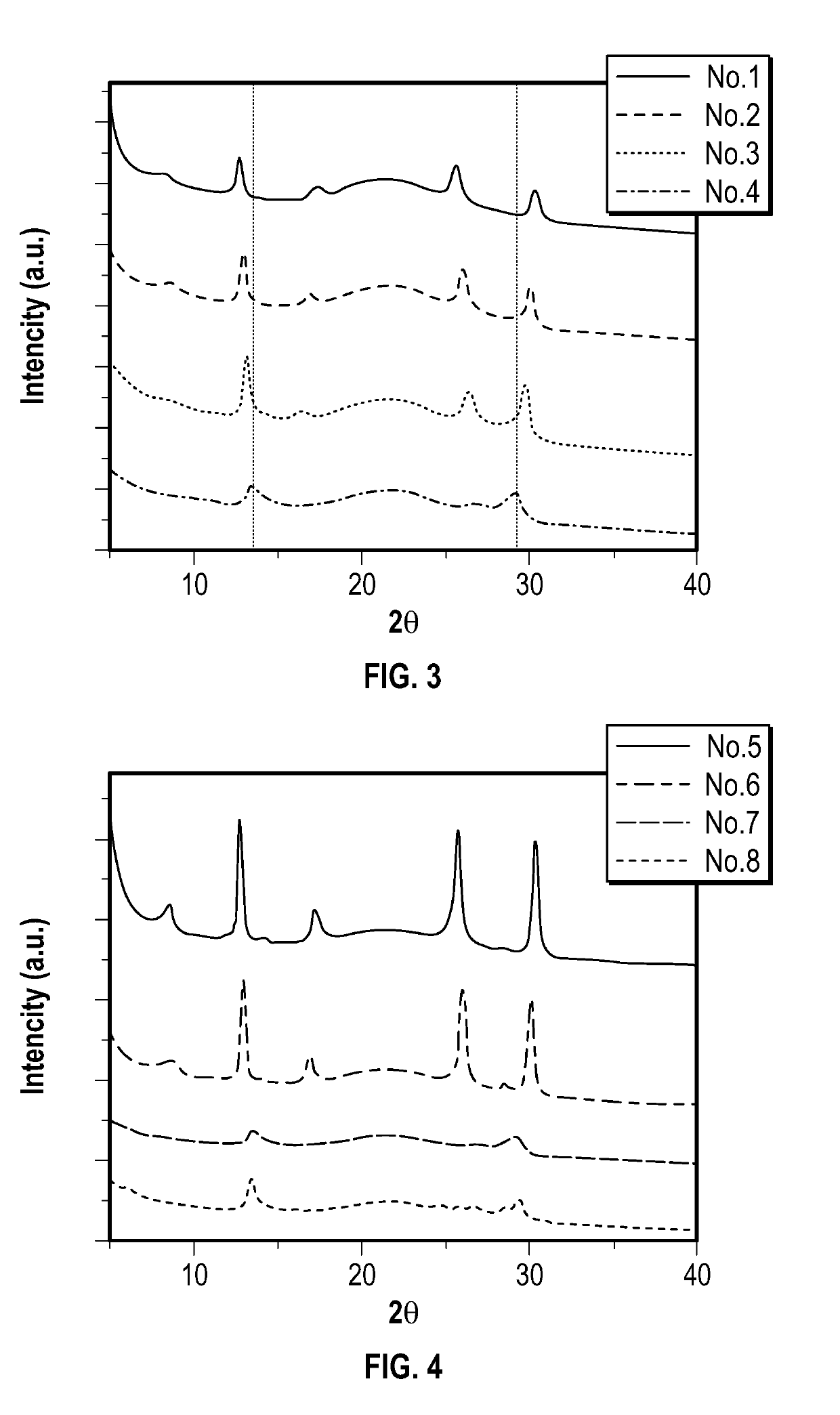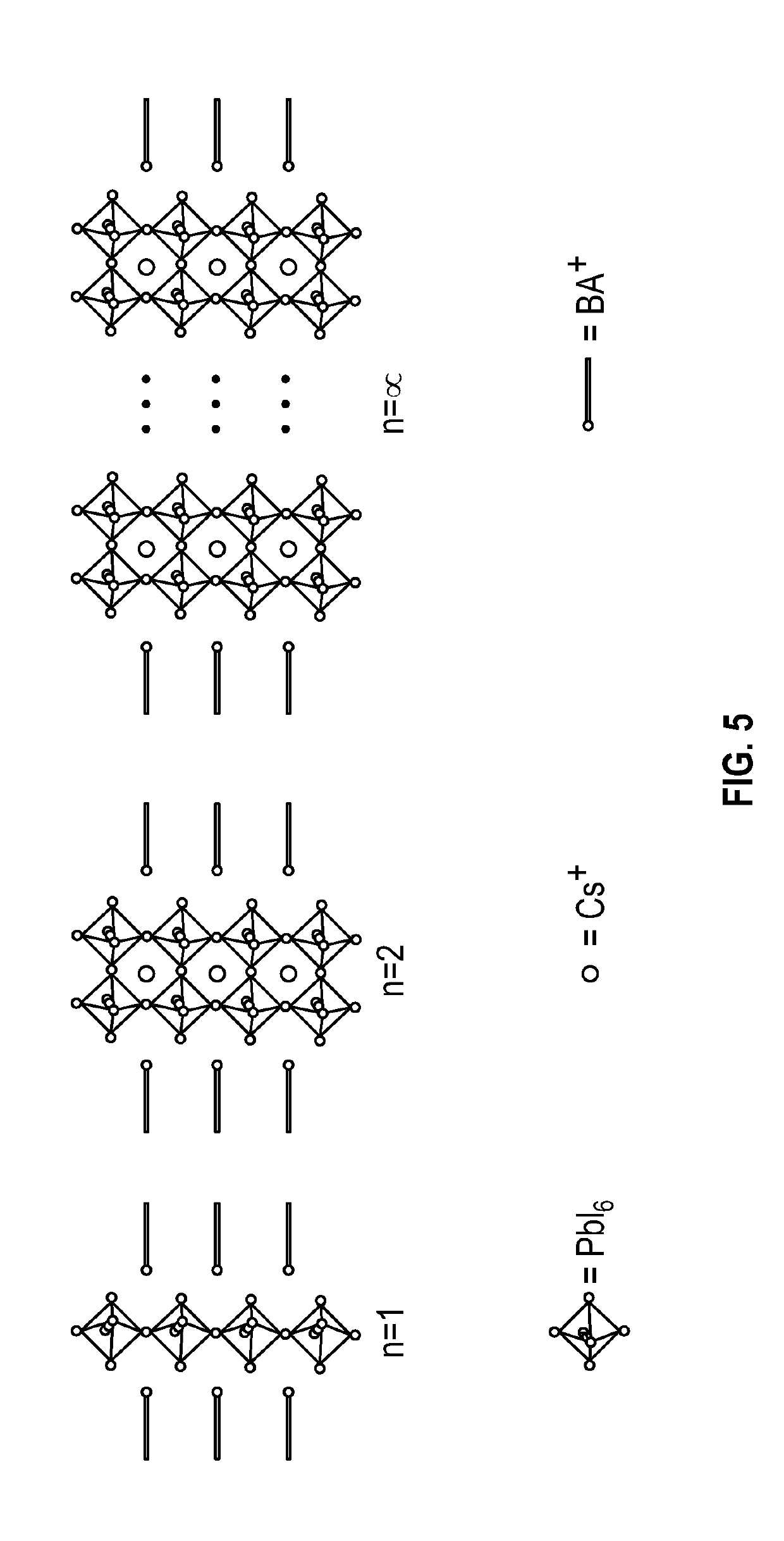Metal Halide Perovskites, Light-Emitting Diodes, and Methods
a technology diodes, applied in the field of metal halide perovskites, light-emitting diodes, and methods, can solve the problems of spectral stability, low spectral stability of mixed halide perovskites, and other possible drawbacks of perovskite leds, and achieve the effect of improving spectral stability
- Summary
- Abstract
- Description
- Claims
- Application Information
AI Technical Summary
Benefits of technology
Problems solved by technology
Method used
Image
Examples
example 1
on of Quasi-2D Perovskite Films
[0090]CsI and PbI2 were dissolved in DMSO at a concentration of 0.35 M. A small amount (1% volume ratio) of acetic acid was added into the solution to increase the solubility of both salts. Benzyl ammonium iodide (BAI) was added to the precursor at molar ratios of 55:45 (No. 1), 50:50 (No. 2), 45:55 (No. 3), and 40:60 (No. 4) to synthesize quasi-2D perovskites with different thicknesses of quantum well structures.
[0091]PEO was dissolved in DMSO with a concentration of 10 mg / mL. The quasi-2D perovskite / PEO solutions were prepared by mixing quasi-2D perovskite and PEO precursors at a 1 to 1 volume ratio. Before spin coating, the mixture precursor was filtered with a glass fiber syringe filter. The mixture precursor was spun-cast at 8000 rpm for 60 seconds, followed by thermal annealing at 70° C. for 20 minutes. Corresponding control samples without PEO were also prepared as No. 5, No. 6, No. 7, and No. 8. Both quasi-2D perovskite / PEO composite films and ...
example 2
brication
[0110]ITO-coated glass substrates were cleaned by successive sonication in a soap solution, deionized water, acetone, and isopropanol for 15 min at 40° C., and UV ozone-cleaned for 20 mins.
[0111]PEDOT:PSS was spun-cast onto the cleaned ITO coated glass substrate at 8000 rpm for 45 s, and baked at 140° C. for 20 min to obtain a 40 nm thick film.
[0112]Poly-TPD in chlorobenzene with a concentration of 8 mg / mL was spun-cast at 3000 rpm for 60 s, following by thermal annealing at 130° C. for 20 min to obtain a 20 nm thickness.
[0113]The poly-TPD films were treated by O2 plasma for 2 s to improve wetting properties.
[0114]After that, a 0.35M quasi 2D perovskite / PEO mixture precursor solution was spin coated on the top at 8000 rpm for 60 s.
[0115]After spin coating, a heat treatment was performed at 70° C. for 20 mins. The final thickness was about 50 nm.
[0116]A 40 nm thick layer of TPBi was then deposited at a rate of 1.0 Å / s under high vacuum (<3×10−6 Torr). After the deposition of...
PUM
| Property | Measurement | Unit |
|---|---|---|
| thickness | aaaaa | aaaaa |
| thickness | aaaaa | aaaaa |
| structure | aaaaa | aaaaa |
Abstract
Description
Claims
Application Information
 Login to View More
Login to View More - R&D
- Intellectual Property
- Life Sciences
- Materials
- Tech Scout
- Unparalleled Data Quality
- Higher Quality Content
- 60% Fewer Hallucinations
Browse by: Latest US Patents, China's latest patents, Technical Efficacy Thesaurus, Application Domain, Technology Topic, Popular Technical Reports.
© 2025 PatSnap. All rights reserved.Legal|Privacy policy|Modern Slavery Act Transparency Statement|Sitemap|About US| Contact US: help@patsnap.com



